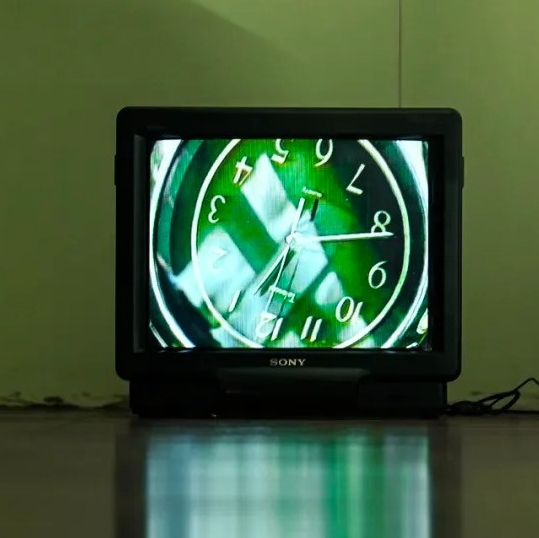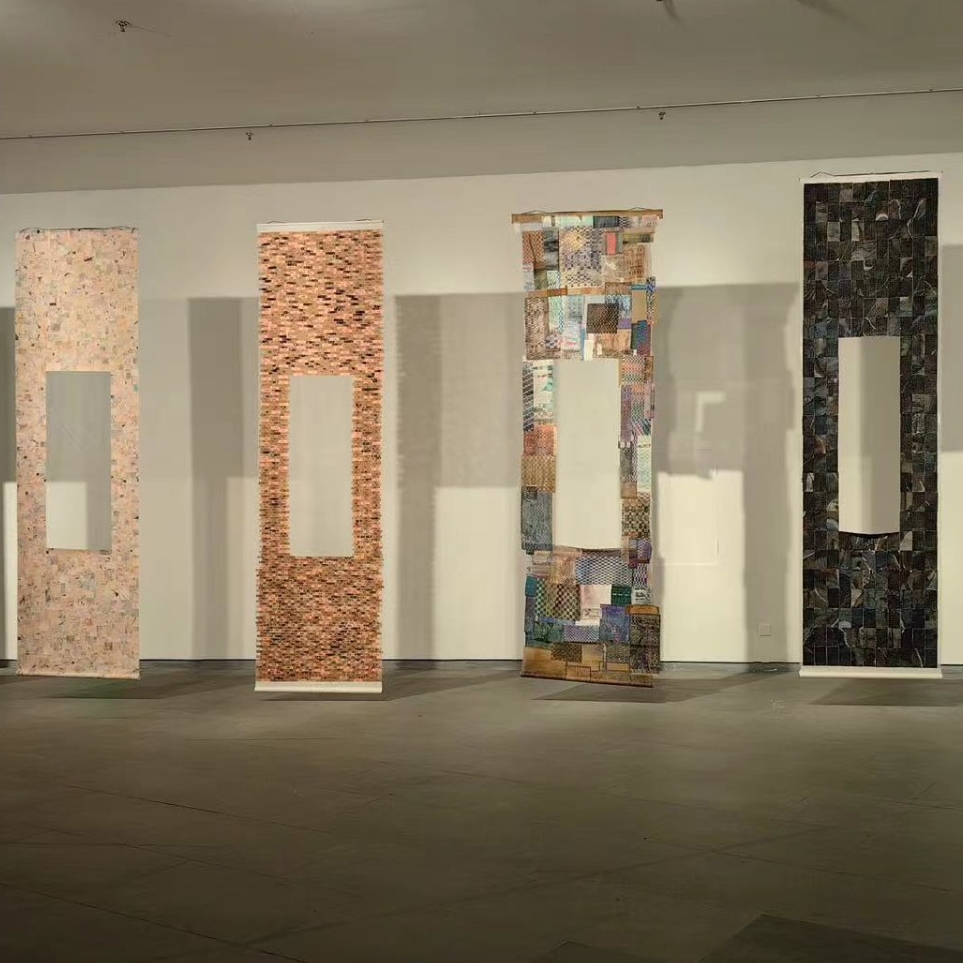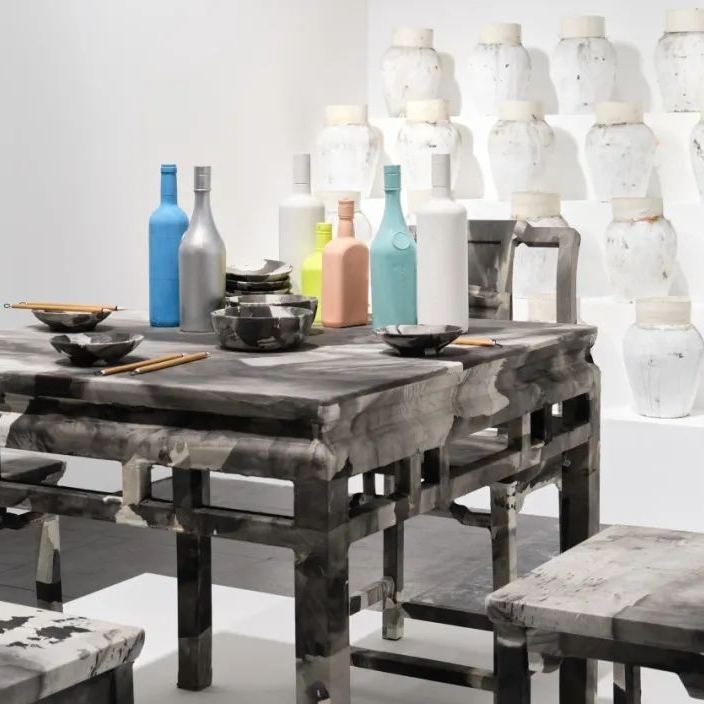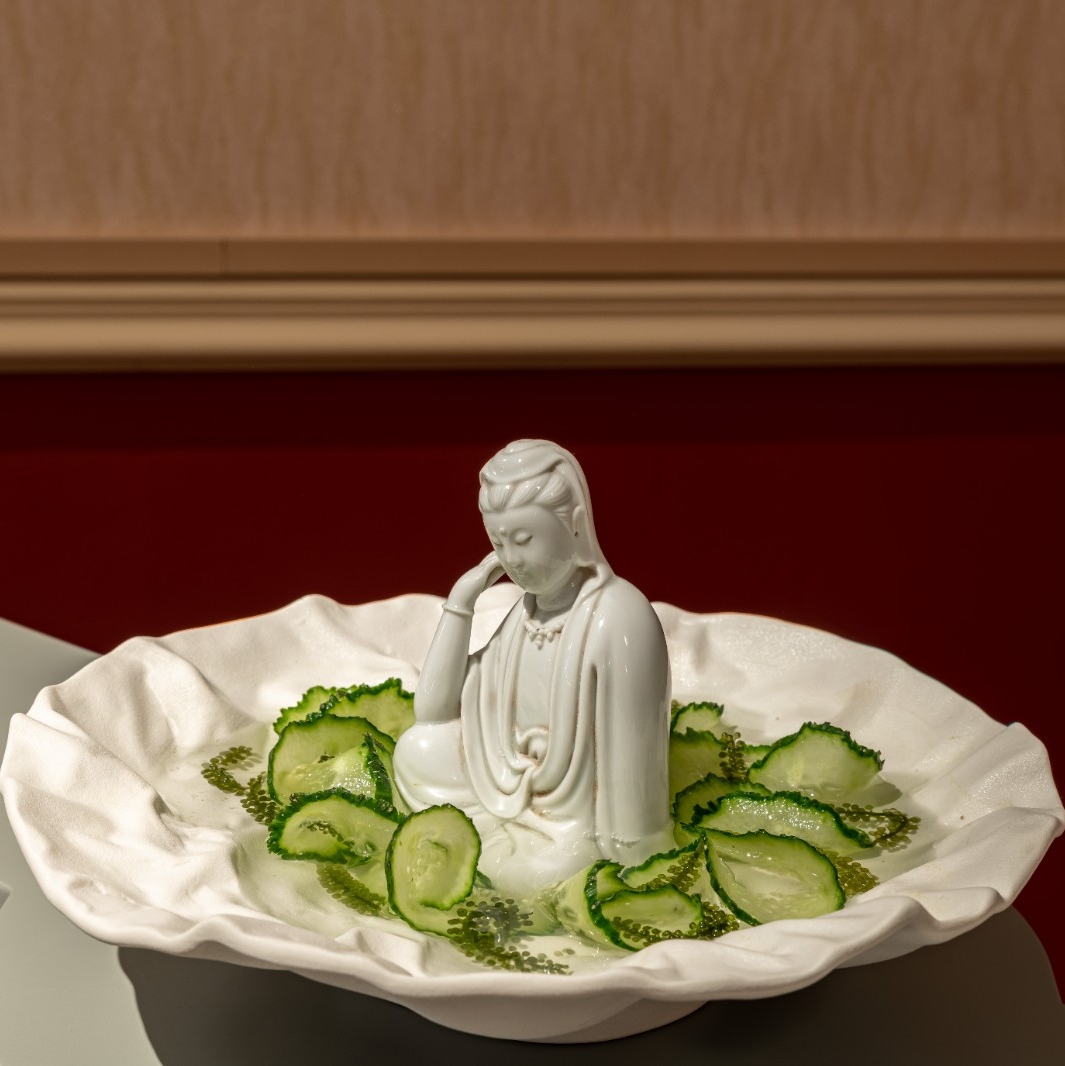The current exhibition “Who is He? A Geng Jianyi Retrospective” at the UCCA Center for Contemporary Art, bears such a succinct and powerful title of “Who is He?” The title refers to a work created by Geng in 1994, and also echoes the retrospective’s in-depth review of Geng’s artistic practice and a profound remembrance of the artist. A quick review of past critiques and interviews reveals that what Geng is most noted for by his peers and audience alike is his unique, alien-like perspective, which is “one of a kind”. Karen Smith summarised it as “sociological-anthropological research or experiment”. Pi Li pointed out that it is the “third-party” perspective. Zhang Ding called it “relational aesthetics”. Zheng Shengtian, who taught Geng at the Zhejiang Academy of Fine Arts (now the China Academy of Art) concluded that it offers “a sense of distance”, which in Zheng’s mind is the most distinctive characteristic of Geng’s personality, and his approach to people and to his work, and also, where Geng’s talent lies.
Installation view of “Who is He? A Geng Jianyi Retrospective,” 2022. Photograph by Sun Shi, courtesy UCCA Center for Contemporary Art.
A similar perspective to that of Geng appeared in literature, as Julio Cortázar, who also dissected the everyday human behaviours and offered an alternative view of the world, he attempted to reconceptualise the function of an armchair and wrote mind-boggling brainy instructions on how to cry, how to sing, how to work, how to climb a staircase, how to wind a watch, and so forth. Together with Geng who broke down the action of clapping and divided wearing clothes into seven steps, they seem to have achieved similar perspectives and similar grey humour in different art fields. Geng once fretted over a starving monkey in his dream that must peel an onion before eating, “How can I make the monkey understand that all of these are not skins?” While Cortázar once said that life was supposed to be lived “as though everything is a miracle”, they both deeply regret the wasted creativity in life.
 Installation view of “Who is He? A Geng Jianyi Retrospective,” 2022. Photograph by Sun Shi, courtesy UCCA Center for Contemporary Art.
Installation view of “Who is He? A Geng Jianyi Retrospective,” 2022. Photograph by Sun Shi, courtesy UCCA Center for Contemporary Art.
It is fair to say that these works, which are intended to raise questions, to re-examine the banal, and to try to inspire unease through imagination and creativity, “representing a real, new vision and evoke intellect and sensation”. But since they are difficult to be described because of their instinct towards resistance against summary and categorisation due to the micro-practices that delve into the everyday realm, here we have to transpose Jorge Luis Borges’s brilliant comment on that literary figure with a peculiar perspective, “No one can retell the plot of a Cortázar story; […] If we try to summarise them, we realize that something precious has been lost.” [1]
I. Kick off Cezanne, kick off Utrillo, kick off Bonnard …
The narrative of the retrospective begins with, by choice, Forms and Certificates, one of the earlier practices of Geng's “50 Percent” approach to creation. In 1988, Gao Minglu, then editor of Art magazine, invited a group of avant-garde artists and critics across northern and southern China, including Geng and Zhang Peili, to attend the Huangshan Conference in preparation for the “China/Avant-Garde Exhibition”. Aged 26, Geng mailed a serious-looking form to each participant on the list, and he received responses from the majority of them. At the Conference, Geng presented the forms filled in every possible way, and each “exhibitor” was awarded an “88 Audience Certificate” by the artist. On the Certificate, there was a print of a joke, “Vegetables don’t taste as delicious as meat.”
 Installation view of “Who is He? A Geng Jianyi Retrospective,” 2022. Photograph by Sun Shi, courtesy UCCA Center for Contemporary Art.
Installation view of “Who is He? A Geng Jianyi Retrospective,” 2022. Photograph by Sun Shi, courtesy UCCA Center for Contemporary Art.
 Geng Jianyi at the Huangshan Conference on Art initiating the second part of Forms and Certificates, 1988.
Geng Jianyi at the Huangshan Conference on Art initiating the second part of Forms and Certificates, 1988.
Among the responses collected by Geng, very few people recognised the Duchampian dry humour and mischievous attributes adulterated in the artist’s serious form and replied “nonsense”. Fei Dawei not only posted the 1-inch photograph of himself upside down, but also left in the column of his favourite plant “Mougeotia birecava” in Chinese and in Latin while putting Sand Monk (translator’s note: one of the three disciples of the Buddhist pilgrim Tang Sanzang in the 16th century Chinese novel Journey to the West), Lei Feng (translator’s note: 1940-1962, a Chinese soldier typically promoted as a paragon of selfless socialism) and Pablo Picasso as his family members. Most people chose to fill in the form seriously, as in the case of Hou Hanru’s answer to the question “favourite person”, “Joseph Beuys”. The different reactions of the collaborators turned the situation into one where very few participants knew it was a joke and responded as such, whereas the vast majority were unsure, but almost no one realised that it was a work. In Forms and Certificates, the artist’s subtle use of and flirtation with “administration”, by weakening subjectivity and emphasising the statute of reason, stimulates various reactions to the institution from the other “50 Percent” of participants. This is reinforced by the context of the conference from which it emerged, making the work, in Zheng Bo’s judgement, “iconic in the art of institutional critique”. [2]
 Geng Jianyi, Haircut No. 3: ’85 Another Shaved Head of Summer, 1985, oil on canvas, 178 x 149 cm. Private collection.
Geng Jianyi, Haircut No. 3: ’85 Another Shaved Head of Summer, 1985, oil on canvas, 178 x 149 cm. Private collection.
 Geng Jianyi, Untitled, 1982, oil on paper, 52 x 42.5 cm. Private collection.
Geng Jianyi, Untitled, 1982, oil on paper, 52 x 42.5 cm. Private collection.
Similar rebellion was evident in Geng’s graduation work, Two People Under a Light. The use of a new artistic language in this work drew criticism from the audience, prompting the artist to consider the gulf between artistic language and audience comprehension and how to address it. His views were published in the article “Artworks and the Audience” in Art News of China, No. 22, 1988, “No matter how hard the artist tries, it is a waste of effort; either for the impotence of the existing language, or for the failed comprehension of the new language.” [3] In the article, he also summarised the different types of relationship between an artist and the audience, such as the “narcissist”, the “hen-pecked husband” and the Duchampian “Cynicist”.
 Geng Jianyi, preparatory works for Interchange of Light, 1993, preparatory works on paper, pen, 6 drawings: 29.7 × 21 cm each. Private Collection.
Geng Jianyi, preparatory works for Interchange of Light, 1993, preparatory works on paper, pen, 6 drawings: 29.7 × 21 cm each. Private Collection.
 Geng Jianyi, Deckled Edge, 1992, oil on canvas, 4 pieces: 63 × 52 cm each, Private collection.
Geng Jianyi, Deckled Edge, 1992, oil on canvas, 4 pieces: 63 × 52 cm each, Private collection.
 Geng Jianyi, Pond Society No. 2: Walker in Green Space, 1986. Courtesy Song Ling.
Geng Jianyi, Pond Society No. 2: Walker in Green Space, 1986. Courtesy Song Ling.
Geng believed that an artist should remove the language barrier as much as possible to facilitate the audience’s comprehension, but at the same time not cede the artist’s position to the audience, as Duchamp did. In this vein, Geng elaborated on the project Tap Water Factory to demonstrate his intention to resolve the communication barrier between art and audience through the audience’s interactive participation. The artwork thus becomes an intermediary between “viewing” and “being viewed”, rather than the focus itself. The art project Tap Water Factory may be seen as a prototype of Geng’s “50 Percent” approach to creation. This “myth”, as Wu Shanzhuan called it, was never fully realised until the restoration in the retrospective at the Power Station of Art in Shanghai.
From exploring the flatness of oil painting to pondering the distance between the artist and the viewer, Geng gradually developed an artistic methodology based on collaboration with the audience or others. Considering his sensitive perspective on the tools of governance such as archive and administration, finding his own way of action (practice) amidst the subtle awareness of the life politics would be a radical practice that is both gentle and humorous.
II. How can I make the monkey understand that all of these are not skins?
Liu Tian breaks down Geng’s artistic work (which Geng prefers to call “practice”) into several facets, which are expressed interestingly with verbs in most cases. Examples are “develop”, “detach”, “re-enact”, “decompose”, “wait”, “ferment”, “collate”, “prove” and so on. [3] The core of Geng’s creation is not the work, but the practice, and the perspective and observation behind it. Liu accurately captures the artist’s emphasis on the characteristic of creation as generating meaning in the process of interpretation and transformation, and these means often appear in combinatorial modes, imposing interpretations on reality, thus deriving a strange absurdity and humour. Hence, the sublime boundaries of art are softened, and the great inertia of the everyday is offset.
Geng’s close friends would argue that the best way to present Geng’s work is not through exhibitions and publications, but through hyperlink-based webpages that may jump freely between different tags, which might include:
Collaboration/Relational Aesthetics: This includes Geng’s collaboration with the audience and his collaboration with others/artists, both of which may in fact be one and the same. As the event organiser (creator), Geng demonstrated a keen awareness of interpersonal relationships, organisational systems and even systemic institutions. Works with this tag may include Tap Water Factory (1987), which reinforces audience participation, but also Who Is He? (1994), Reasonable Relationship (1994) and The Needs of Negative Reality (1995) and many others that resulted from his collaboration with others/artists. Collaboration is part of Geng’s signature approach to creation.



Geng Jianyi, Who Is He?, 1994, 26 pieces: written statements, drawings, and photographs, A4. Written statements: 29.7 × 21 cm each, photographs: 20.3 × 15.2 cm each. Kröller-Müller Museum, Otterlo, the Netherlands.
Collate: The next step after collaboration is collation, with typical examples being Note Books (1995), Useless (2004), etc.
 Geng Jianyi, Note Books, 1995, notebooks filled with hand-written text, 11 books: 13.2 × 9.3 × 1 cm each. Courtesy Guan Yi Contemporary Art Archive Collection.
Geng Jianyi, Note Books, 1995, notebooks filled with hand-written text, 11 books: 13.2 × 9.3 × 1 cm each. Courtesy Guan Yi Contemporary Art Archive Collection.
 Geng Jianyi, Note Books (detail), 1995, notebooks filled with hand-written text, 11 books: 13.2 × 9.3 × 1 cm each. Courtesy Guan Yi Contemporary Art Archive Collection.
Geng Jianyi, Note Books (detail), 1995, notebooks filled with hand-written text, 11 books: 13.2 × 9.3 × 1 cm each. Courtesy Guan Yi Contemporary Art Archive Collection.
 Geng Jianyi, The Needs of Negative Reality, 1995, installation view of The Needs of Negative Reality, Art Omi Residency, upstate New York, forms completed by residency participants, pedestal.
Geng Jianyi, The Needs of Negative Reality, 1995, installation view of The Needs of Negative Reality, Art Omi Residency, upstate New York, forms completed by residency participants, pedestal.
Prove: Forms, letters, notes and other written forms appear prolifically as a way of “proving” in Geng’s works. For example, Proof of Existence (1998) and Definitely Him / Definitely Her (1998). In most cases, the artist further manipulates these proofs, as in Proof of Existence where the ID portrait is enlarged to the size of a “leader’s portrait”, thus emphasising or dismantling the power of the “proof” itself and endowing the work with a new context and meaning.
 Installation view of “Who is He? A Geng Jianyi Retrospective,” 2022. Photograph by Sun Shi, courtesy UCCA Center for Contemporary Art.
Installation view of “Who is He? A Geng Jianyi Retrospective,” 2022. Photograph by Sun Shi, courtesy UCCA Center for Contemporary Art.
Displace and repeat: This includes spatial displacement, and repetition in action and behaviour, sometimes at cross-purposes. Examples are Reasonable Relationship (1994), Do Yourself in a Right Way (2005), Offset (2007), and another relatively independent thread of his practice, The “Book” series, which revolves around books.
 Geng Jianyi, Artwork from the “How Could a ‘’ Character Be Enough” series, 1999, blank book, and coloured pencil on paper, 25.7 × 19.2 × 2.7 cm. Private collection.
Geng Jianyi, Artwork from the “How Could a ‘’ Character Be Enough” series, 1999, blank book, and coloured pencil on paper, 25.7 × 19.2 × 2.7 cm. Private collection.
Decompose: Seven Steps of Wearing Clothes (1991), Three Steps of Clapping (1994), and Decomposing a Movement (1998) achieve an unusually clear expression of the artist here by decomposing the physical acts that permeate everyday life. As he says, “Teaching people how to perform everyday acts particularly has an ulterior motive; once the acts ‘are cultured’, it means that the instinct is lost.”
 Geng Jianyi, First Series of Seven Steps of Wearing Clothes, 1991, collage of printed images, and wood, 122 x 147 cm. Courtesy Guan Yi Contemporary Art Archive.
Geng Jianyi, First Series of Seven Steps of Wearing Clothes, 1991, collage of printed images, and wood, 122 x 147 cm. Courtesy Guan Yi Contemporary Art Archive.
 Geng Jianyi, Three Steps of Clapping, 1994, silkscreen, 3 pieces: 30 × 35 cm each, overall 92 × 37 cm. Private collection.
Geng Jianyi, Three Steps of Clapping, 1994, silkscreen, 3 pieces: 30 × 35 cm each, overall 92 × 37 cm. Private collection.
 Geng Jianyi, preparatory works for Decomposed Action, 1991, black-and-white photographs and photocopy montage on paper, 2 pieces: 19 × 13 cm each. Private Collection.
Geng Jianyi, preparatory works for Decomposed Action, 1991, black-and-white photographs and photocopy montage on paper, 2 pieces: 19 × 13 cm each. Private Collection.

Geng Jianyi, preparatory works for Decomposed Action, 1991, black-and-white photographs and photocopy montage on paper, 2 pieces: 19 × 13 cm each. Private Collection.
Develop: Geng Jiangyi has created a large number of photographs with an unconventional sense of how to “develop” on a flat surface experimenting with various possibilities. Sometimes it is like a game, for instance, “scanning” a crack on the concrete floor with a pencil and framing the scan. At other times, randomness is allowed to run its course, letting the ink paste leave striking red fingerprints and reading body trails on the book, overlaying words on a book until it loses any readability, or playing a game of development in the darkroom where the liquid flows freely over the negative, developing it “independently”, and so forth.
Time: Part of the depth and unique taste of Geng’s work depends on the fermentation with time, as in the case of Forms and Certificates, which has acquired a documentary significance and interpretive space in the present, and in the case of Tap Water Factory, which was revived at the Power Station of Art in Shanghai in 2022, where the number of selfies taken by the audience increased significantly. Both examples have added another dimension to the discussion of “viewing” and the relationship between art and the audience. Geng understood well the significance of time and sedimentation, otherwise why did he include in his will when he was seriously ill that no solo exhibition or publication shall proceed within five years upon his death?

The “glossary” above on Geng’s artistic practice is like the non-existent, strange characters invented by Cortázar, which appear as if people should be familiar with their existence. Similar artists have always had the ability to resist “all that is licked by habit to the point of being satisfyingly silky” [4] outside the web of common sense and order and against the comforting force of inertia. The regret of such an artist’s passing is that, we will forever lose his perspective on the world, and his access to a world that could have existed through his eyes, his thoughts and his actions. A loss like this can never be truly compensated for.
Text (CN) by Du Mengxi, edited (EN) by Sue/CAFA ART INFO
Image Courtesy of UCCA Center for Contemporary Art.
References:
[1][4] Cronopios and Famas, [Argentina] Julio Cortázar
[2] “Procrastinating in the Pyramid: Geng Jianyi’s Institutional Critique”, Zheng Bo
[3] “An Argument at the Zhejiang Academy of Fine Arts”, originally published in Art magazine, No. 9, 1985





























